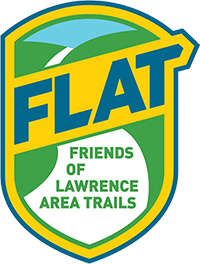Perry and Clinton Lake Trails built by dedicated nature lovers
Ever wonder who built the trails you enjoy today? In this post, Carl Ringler, who led the creation of the Clinton Lake Trails, tells the story of the trail system’s development. Thank you to Carl for providing this history, and for the countless hours spent building and maintaining trails that today’s adventurers enjoy.
Clinton State Park was created in the early 1980’s when the dam across the Wakarusa was built to form Clinton Lake. In November of 1980 the Kansas Trails Council began designing the Northshore Trail System. Eleven miles of trail were built over the course of several years. They extended from the Corps of Engineers Overlook Park to the public boat ramp at the west end of the park. A four mile section of trail from the boat ramp west into the Corps of Engineers area was also built, but had been abandoned.
Meanwhile, in 1988, Carl Ringler responded to a request for help with the maintenance of the trails at Perry Lake State Park. It was at this maintenance party that he met Richard Douthit, a professor of communications at the college in Emporia, who was an ardent advocate of trails and the coordinator for the trails on the east side of Perry Lake. They became good friends, despite Richard’s opposition to allowing mountain bikes to use the trails at Perry Lake. Carl later volunteered to become a trail watcher
for a section of the Perry Lake Trail and served in that capacity for a year or so. He applied for and became the coordinator for the trails at Clinton Lake. The coordinator’s position had been vacant there for several years and the trails had become overgrown and hard to find in places. He set about organizing work parties to clear them and pick up the litter left by careless campers and hikers. Trail blazes were repainted and the trail use picked up significantly.
In 1989, on a recommendation from the Kansas Trails Council, the Clinton State Park trails were opened to mountain bicycle use, with the condition that if the trails were negatively impacted, the bicyclists would be prohibited from using them. At the end of the one-year trial period, trail conditions had actually improved, becoming smoother and more well defined.
Over the next 4 years, the Kansas Trails Council (under the direction of its trails coordinator for the area, Carl Ringler) designed and built an additional 14 miles of hiking/biking trails in the park. In the Spring of 1996, the trail head was moved approximately 100 yards to the west and additional parking was added to
accommodate the ever-increasing number of trail users. The original trail head was preserved for those using the overlook picnic area or hiking to Sanders Mound.
Over the years, many people contributed to the construction and maintenance of the trails on the north shore of the lake. Kathy Porsch signed on as a trail watcher and spent many hours working by herself to maintain the section for which she assumed responsibility, primarily the area below campground 3. Bud and Dolores Baker, long time Kansas Trails Council members, came up one weekend to help build what became known as the Fredonia section, which lies just west of campground 1. One weekend years later, a large group of individuals gathered to help clean up an old dump site in that trail section, hauling numerous garbage cans full of tin cans, bottles and other miscellaneous items upslope to a truck the state park provided.
Barbara Page, Carl’s wife, also contributed many hours to the construction and maintenance of the trails, participating in most, if not all, of the trail construction and maintenance parties.
In 1999, Carl Ringler and his wife, Barbara moved to Washington state and left the trails at Clinton in the hands of others, who would step in and take over the maintenance of the trails. Neil Taylor, a fellow mountain biker, was one of those, who took a great interest in them and became a trail watcher. Mike Goodwin is the current coordinator for the trails.
After Carl’s departure, the development of the trails system at the park continued, with new trails being added periodically. A new section was added near the shoreline below Land’s End, with a considerable effort. Large slabs of stone were moved to create a very challenging trail there. Also, a skills area was added on the north side of the road at the west end of the park, with teeter totters, log climbs and other obstacles, in an area that had been mostly ignored.
Over the course of several years, Carl held a series of mountain bike races on the trails. One hundred percent of the proceeds from the races (roughly $5000) were donated to the park, with the understanding that they would be used for the construction of facilities providing access to people with disabilities. In fact, this contribution did lead to the construction of fishing areas below campground 3 built with wheelchair access in mind. Picnic tables with wheelchair access were placed in this area as well.
The American Discovery Trail, a coast-to- coast hiking/biking trail was proposed and designed in the 1980’s. The route was to have included trails along the north shore of Clinton Lake, including some yet to be built through the Corps of Engineers land. Dick Dilsaver, formerly with the Coleman Corporation, headed up the effort to lead the ADT research crew through the area. Carl Ringler hiked the route with the three ADT crew one winter day, on which they were able to walk across the lake on the ice to
shortcut the route that went north to cross Coon Creek. Ultimately, the ADT failed to materialize, but the groundwork was laid for a trail that might someday cross the continent, linking numerous bits of local trail.
